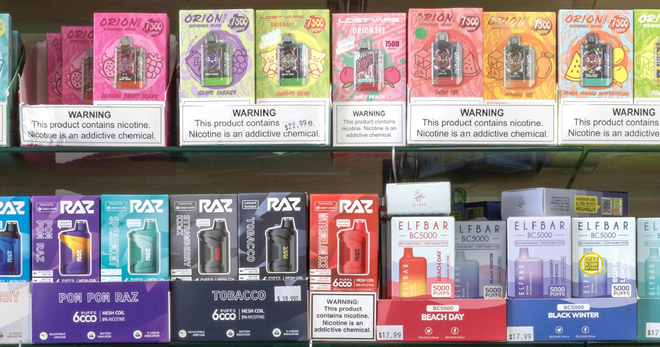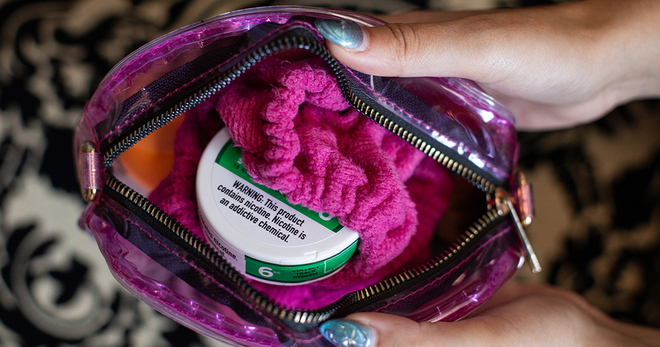4 things parents need to know about JUUL and nicotine addiction
If you are the parent of a middle or high school student, you may already know that the popular new e-cigarette JUUL is reigniting concerns about nicotine addiction in youth.
JUUL has been making headlines and prompting crackdowns from the Food and Drug Administration for its popularity among teens. The device, which captured 68 percent of the e-cigarette market in just two years, has caused alarm in schools across the country due to widespread reports of its use on school property.
"I think parents really need to know what’s going on in the schools, and I think they’d be shocked," said Dr. Judy Groner, chair of the American Academy of Pediatrics Section on Tobacco Control and a pediatrician at Nationwide Children’s Hospital in Columbus, Ohio. "We need to have teachers, principals, school personnel and parents all aware of what this product is, what it looks like and what it’s doing to the kids."
We talked with Dr. Groner about four things parents should know about JUUL and nicotine addiction.
1. JUUL has a higher nicotine content than many other e-cigarettes.
While e-cigarettes are less toxic than cigarettes, they still contain toxins and the addictive chemical nicotine, which is harmful to adolescent brain development. The adolescent brain is also more susceptible to addiction.
The amount of nicotine in one JUUL cartridge is roughly equal to the amount of nicotine in a pack of cigarettes, or about 200 puffs, according to the product website. That’s double the concentration of nicotine found in other e-cigarettes, the American Academy of Pediatrics stated in its resource "JUULing: What Pediatricians and Families Need to Know."
"I think everybody has been caught unaware as to how incredibly addictive JUUL is," said Groner, who added that she and many pediatricians are "very concerned about addiction."
2. The ability to hide JUUL enables frequent use.
JUUL is easy to hide from parents and teachers because it looks like a flash drive and can be charged in a USB port. It also does not produce a strong odor.
These characteristics enable discreet use, especially in schools. In fact, almost one-fifth of middle and high school students have seen JUUL used in school, according to an April 2018 Truth Initiative® survey of more than 1,000 youth between 12 and 17 years old.
"They can sneak it into their pocket and carry it with them all the time and take a couple puffs in the bathroom or even in the classroom," Groner said. "They're getting that much more nicotine over the course of the day."
3. Kids are attracted to flavored e-cigarettes and believe they are less harmful.
JUUL comes in a variety of flavors, such as fruit medley, mango, cool cucumber and creme brulee. Flavors in tobacco products, including e-cigarettes, have been found to attract kids.
Research shows that young people are more likely to try flavored e-cigarettes and believe that they are less harmful than tobacco-flavored e-cigarettes. Many youth e-cigarette users also incorrectly believe they aren’t consuming nicotine. The majority of youth e-cigarette users think they consumed only flavoring, not nicotine, the last time they used a product, according to an annual national survey of more than 40,000 students from the University of Michigan 2016 Monitoring the Future study.
"It is no wonder that JUUL e-cigarettes have rapidly caught on with youth — they look like a sleek USB flash drive, are easily concealed and come in youth-appealing flavors like mint, mango and creme brulee," said Robin Koval, CEO and president of Truth Initiative. "Unfortunately, young people are unaware that JUUL packs a powerful nicotine punch with a single cartridge equal to an entire pack of cigarettes. This escalates the urgency for FDA regulation and public education regarding the risks for young people."
4. Pediatricians are still learning about JUUL.
Detecting and monitoring JUUL use can be a challenge for pediatricians. A Truth Initiative study published in Tobacco Control found that many young people refer to the use of JUUL as "JUULing," indicating that it is so distinctive, it is perceived as its own category.
"The people who use JUUL don’t consider themselves smokers and they actually don’t consider themselves vapers. They use the term ‘JUUL,’ and if pediatricians aren’t aware of what JUUL is, they might not even ask the right questions," Groner said.
"They need to be able to have honest conversations with their patients about how difficult it’s going to be for them to quit and why they shouldn’t start," Groner said, "especially if kids are in social circles where their friends are using it, but they themselves have not tried it, which is very common."
E-cigarettes are putting an entire generation at risk of nicotine dependence. Truth Initiative, the American Academy of Pediatrics, other public health and medical groups and individual pediatricians filed a federal lawsuit challenging an FDA decision to delay fully regulating e-cigarettes until 2022 — a full five years past the original deadline, and six years since the FDA finalized a rule to have regulatory authority over all tobacco products. The groups are also calling on the FDA to take immediate action to address the rising popularity of JUUL among youth, as well as a slew of copycat products that have been introduced in recent months.
The surgeon general declared in a 2016 report that e-cigarette use among young people "is now a major public health concern" because early e-cigarette use and nicotine addiction can harm brain development and increase the risk of young people smoking cigarettes.
More in emerging tobacco products
Want support quitting? Join EX Program
By clicking JOIN, you agree to the Terms, Text Message Terms and Privacy Policy.
Msg&Data rates may apply; msgs are automated.


